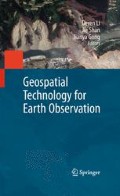Abstract
A great progress in Earth sciences in the past century is Earth Observation (EO) from space and storing, managing, and distributing remotely sensed data via networked geographic information systems (GIS). Various topographic maps, thematic maps, ortho-images, and other products can be obtained from remotely sensed data by air-borne and space-borne remote sensing sensors within the electromagnetic spectrum, including visible, infrared, and microwave bands. Weather forecasts, natural resource exploitations, environmental monitoring, crop yield estimations, land use, land cover change, and prediction and prevention of natural hazards, such as sandstorms, droughts, floods, volcanoes, and earthquakes, can be carried out with Earth observation technology. New Earth observation technology improves the living standards of human beings and the development of social economy. It has contributed greatly to the sustainable development and research of Earth science.
Access this chapter
Tax calculation will be finalised at checkout
Purchases are for personal use only
Preview
Unable to display preview. Download preview PDF.
References
Beyer HA (1992) Geometric and radiometric analysis of a CCD-Camera based photogrammetric close-range system. PhD thesis, Institut fur Geodasie und Photogrammetry, Nr. 51, ETH, Zurich, May 1992
Bianconi M, Crespi M, Fratarcangeli F, Giannone F, Pieralice F (2008) A new strategy for rational polynomial coefficients generation. Proceeding EARSeL Joint Workshop Remote Sensing, New Challenges of High Resolution, Bochum (Germany) March 5-7 2008
Brovelli M.A, Crespi M, Fratarcangeli F, Giannone F, Realini E (2008) Accuracy assessment of high resolution satellite imagery orientation by leave-one-out method, ISPRS Journal of Photogrammetry and Remote Sensing, Vol.63 Issue 4 pags. 427-440
Brown DC (1971) Close-range camera calibration. Photogrammetric Engineering. Vol.37, No. 8, pp.855-866
Crespi M, Fratarcangeli F, Giannone F, Pieralice F (2008a) Orientation Of Quickbird, Ikonos and Eros A Stereopairs by an Original Rigorous Model International Calibration and Orientation Workshop. Proceeding of EuroCOW 2008, Castelldefels (Spain) January 30-February 1 2008
Crespi M, Fratarcangeli F, Giannone F, Jacobsen K, Pieralice F (2008b) Orientation of Cartosat-1 Stereo Imagery. Proceeding of EARSeL Joint Workshop Remote Sensing, New Challenges of High Resolution, Bochum (Germany) March 5-7 2008
Elisseeff A, Pontil M (2002) Leave-one-out error and stability of learning algorithms with applications. Advances in Learning Theory: Methods, Models and Applications:111-130. NATO Advanced Study Institute on Learning Theory and Practice
Fraser C S and Hanley H B (2003) Bias compensation in rational functions for Ikonos satellite imagery Photogrammetric Engineering and Remote Sensing, Vol. 69(1), pp. 53-57
Geisser S (1975) The predictive sample reuse method with applications. Journal of the American Statistical Association, Vol. 70, No. 350, pp.320-328
Giannone F (2006) A rigorous model for High Resolution Satellite Imagery Orientation. Phd Thesis of the Sapienza University of Rome. Supervisors: M. Crespi. Available: http://w3.uniroma1.it/geodgeom/personale.htm#DottoriRicerca
Golub G, Van Loan C F (1993) Matrix computation. The Johns Hopkins University Press, Baltimore and London
Hanley H B, Fraser C S (2004) Sensor orientation for high-resolution satellite imagery: further insights into bias-compensated RPC, Available: http://www.isprs.org/istanbul2004/comm1/papers/5.pdf
Hofmann Wellenhof B, Lichtenegger H, Wasle E (2008) GNSS Global Navigation Satellite System, Spinger-Verlag. ISBN: 978-3-211-73012-6
Jacobsen K (1998) Geometric calibration of space remote sensing cameras for efficient processing. IAPRS, Vol. 32, Part 1, pp. 33-43
Kaula WM (1966) Theory of Satellite Geodesy. Blaisedell Publishing Company
Montenbruck O, Gill E (2001) Satellite orbits. Springer, Berlin
Neumaier A (1998) Solving ill-conditioned and singular linear systems: a tutorial on regularization SIAM Review, Issue 3, Vol. 40 pp. 636-666
NIMA (2000) The Compendium of Controlled Extensions (CE) for the National Imagery Transmission Format (Version 2.1) NITFS technical board
Noerdlinger PD (1999) Atmospheric refraction effects in earth remote sensing. ISPRS Journal of Photogrammetry & Remote Sensing Vol. 54, pp. 360–373
Pieralice F (2007) Orthorectification of IKONOS High Resolution Satellite Imagery: definition, implementation and accuracy assessment of an original orientation model. Degree thesis of the Sapienza University of Rome. Supervisors: M. Crespi. Not published
Poli D (2005) Modelling of spaceborne linear array sensors. Diss., Technische Wissenschaften ETH Zurich, Nr. 15894, IGP Mitteilung
Simon R, Dobbin K, McShane L M (2003) Pitfalls in the Use of DNA Microarray Data for Diagnostic and Prognostic Classification. JNCI Journal of the National Cancer Institute 2003 95(1), 14-18. Oxford University Press
Stone M (1974) Cross-validatory choice and assessment of statistical predictions (with discussion). Journal of the Royal Statistical Society B, No. 36, pp.111-147
Strang G, Borre K (1997) Linear algebra, Geodesy and GPS. Wellesley-Cambridge Press, Wellesley
Tao C V, Hu Y (2001a) The rational function model-A tool for processing high resolution imagery Earth Observation Magazine, Vol. 10 (1), pp. 13-16
Tao C V, Hu Y (2001b) A comprehensive study of the rational function model for photogrammetric processing Photogrammefric Engineering & Remote Sensing, Vol. 67(12), pp. 1347-1357
Tao C V, Hu Y (2001c) Use of the rational function model for image rectification Canadian Journal of Remote Sensing, Vol. 27(6), pp. 593-602
Tao C V and Hu Y (2002) 3D reconstruction methods based on the rational function model. Photogrammetric Engineering &Remote Sensing, vol. 68(7), pp.705-714
Teunissen P.J.G, Kleusberg A (1998) GPS for Geodesy, Springer-Verlag. ISBN: 3-540-63661-7
Toutin T, Chénier R, Carbonneau Y (2000) 3D models for high resolution images: examples with Quickbird, Ikonos and EROS In Proceedings of ISPRS Commission IV Symposium, Joint International Symposium on Geospatial Theory, Processing and Applications, Ottawa, pp. 547-551
Westin T (1990) Precision rectification of SPOT imagery. Photogrammetric Engineering and Remote Sensing Vol.56, n. 2, pp. 247–253
Author information
Authors and Affiliations
Editor information
Editors and Affiliations
Rights and permissions
Copyright information
© 2010 Springer Science+Business Media, LLC
About this chapter
Cite this chapter
Li, D. (2010). An Overview of Earth Observation and Geospatial Information Service. In: Li, D., Shan, J., Gong, J. (eds) Geospatial Technology for Earth Observation. Springer, Boston, MA. https://doi.org/10.1007/978-1-4419-0050-0_1
Download citation
DOI: https://doi.org/10.1007/978-1-4419-0050-0_1
Published:
Publisher Name: Springer, Boston, MA
Print ISBN: 978-1-4419-0049-4
Online ISBN: 978-1-4419-0050-0
eBook Packages: Earth and Environmental ScienceEarth and Environmental Science (R0)

